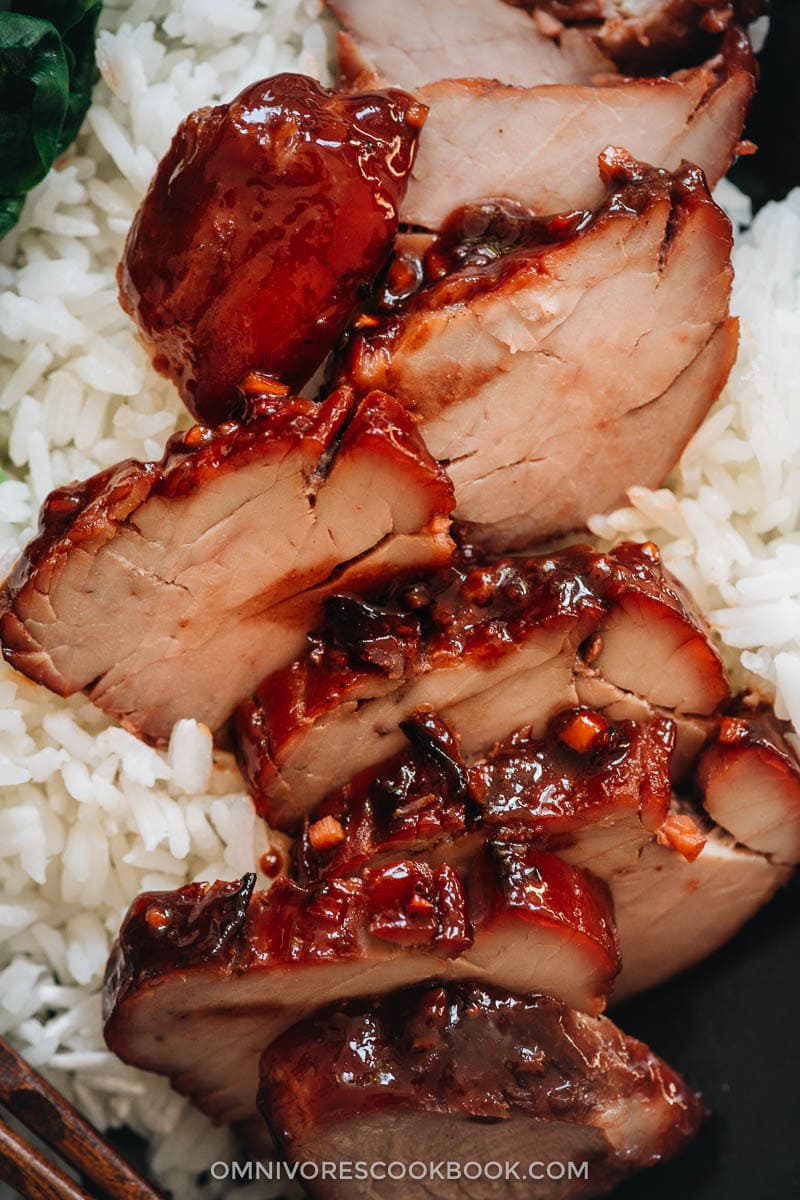
Hailing from Guangdong province in the south of China, char siu or barbecued pork is one of the darlings of dim sum, firmly in the catalog of Cantonese cuisine.
It doesn’t do the dish justice, merely to describe char siu with words. But it is a lean cut of barbecued pork, given a deep red color and shiny coating from the glaze. And it’s famously sweet. However, simply calling it sweet does not convey the complex flavors that result from the long marinating process.
The name Char Siu (or Cha Shao), literally means ‘fork roast’ due to the traditional way of cooking. After marinating, the pork is hung on a special fork and placed in the oven for roasting. During the roasting, the chef will baste the pork with a sugary glaze many times, giving it that appetizing glossy look.
A good char siu should be slightly chewy, juicy, with a vibrant, rich color and an equally alluring aroma. There are so many char siu recipes out there that simply yield a sweet piece of pork. For me, it’s important to create a good marinade base to give the cut a fragrant taste, and add just enough sweetness to complete it. That’s why you will see a lot of fresh aromatics and maybe less sugar in this recipe.
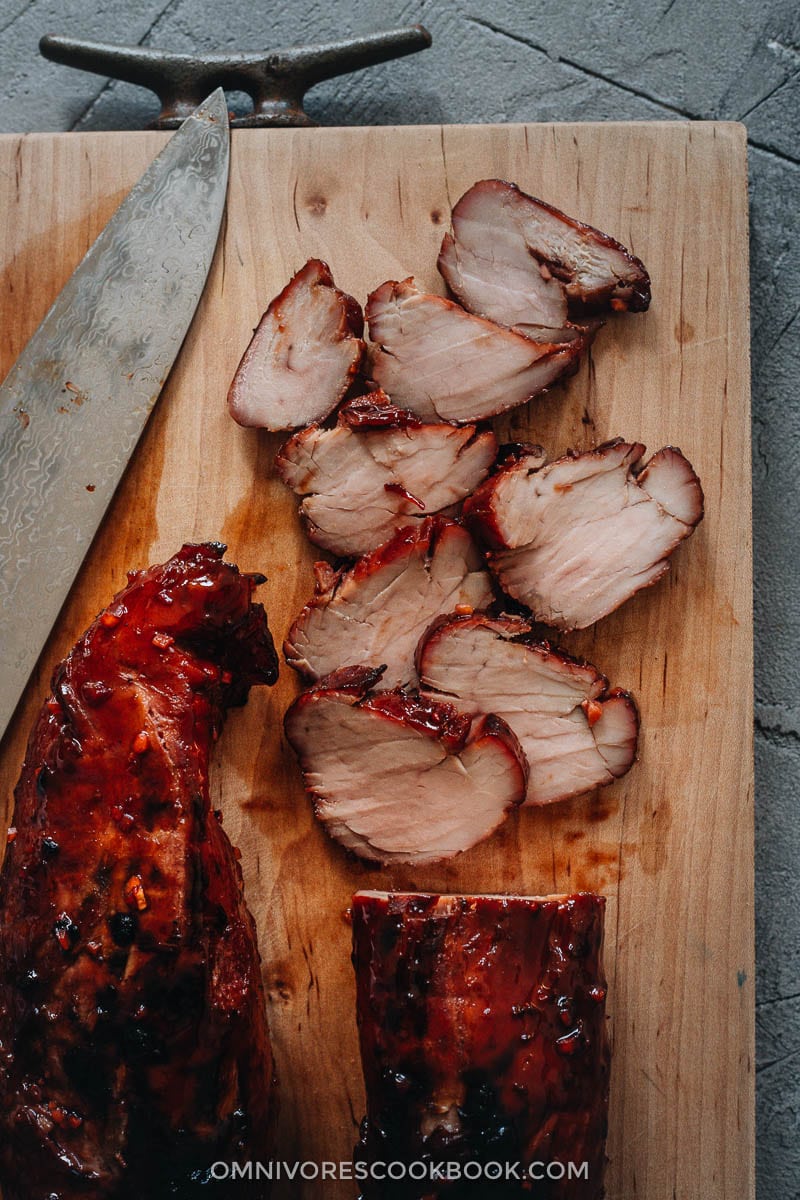
Cooking notes
1. Recipe update
The recipe was originally published three years ago. Over the years I’ve been trying to perfect the process. Today I’m sharing an updated version.
In this version I made a few small changes:
- Added molasses to the marinade to give the pork a better glaze.
- Reduced the soy sauce to create a thicker sauce, so it hangs onto the pork during roasting.
- Used maltose so the pork will have a glossy look, like in Cantonese restaurants.
- Simplified the baking and basting process.
2. What cut of pork for Char Siu
In this recipe I used pork tenderloin which is the lean cut traditionally used in Cantonese restaurants. You can also use pork loin if you want a slightly cheaper cut. Some people enjoy Chinese BBQ pork made from a fattier cut, for example, pork leg, or even pork belly. You can adapt the recipe according to your preference.
No matter which cut you use, you should cut it into pieces about 2” (6 cm) wide and 1”(3 cm) thick, so the baking time will remain the same.
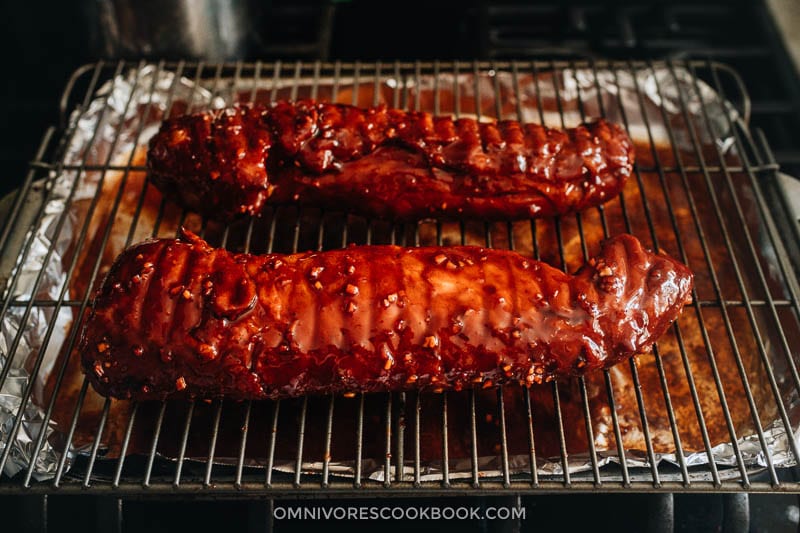
3. An introduction to Maltose
Maltose is a super thick syrup that’s commonly used in traditional Chinese cooking. It is the secret ingredient that gives the char siu its beautiful glossy look.
Maltose is made from rice and malt. At room temperature, it’s ten times thicker than your regular syrup. It won’t fall from the cup if you hold it upside down. If you dig your spoon into it, it will feel very tough and difficult to stir. It will become more runny once heated up, but still quite sticky. That’s why it gives the BBQ pork a better glaze that sticks to the surface.
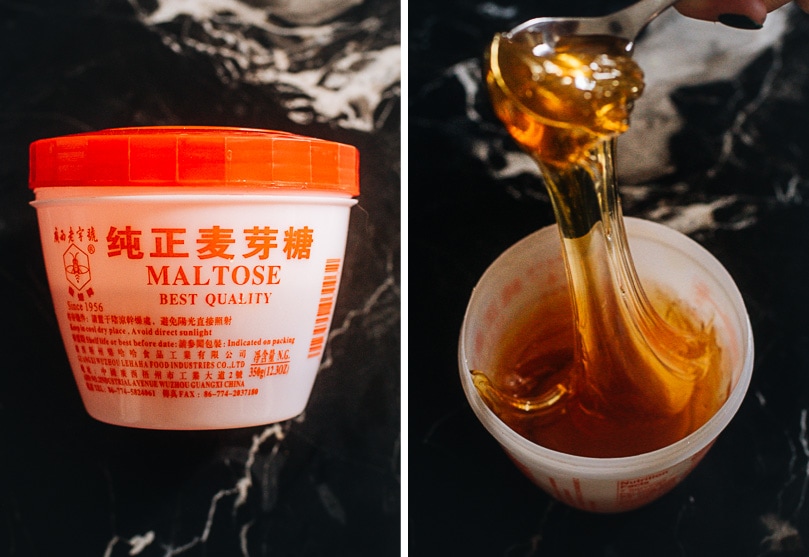
To use maltose, I usually microwave the jar for 20 seconds to get the surface softened. Otherwise it’s very hard to measure the correct amount. Once heated up, the sugar gets VERY HOT. Avoid touching the hot sugar with your hand.
A quick tip: coat your measuring spoon with a thin layer of oil before scooping out the maltose. The sugar will fall from the spoon much easier.
These days you can easily get maltose on Amazon, although you can also get a jar for less than two bucks at an Asian market.
If you don’t want to use maltose, you can use honey to replace it. The coating will not stick as well but it will still end up delicious.
4. Workflow
Making char siu is a two-step process. If you plan ahead and get organized, it’s quite simple to make.
(1) Mix the sauce and marinate one day before cooking
- You will use half of the sauce to marinate the pork. To give the pork as much flavor as possible, make sure to marinate it overnight.
- Cook the other half of the sauce with maltose. Store it in a jar to use for the glaze.

(2) Roast (or grill) the pork
- Set up your oven or heat up the grill.
- Brush the glaze over the pork multiple times while roasting (or grilling). To make the sauce stick better, use a brush to dab the glaze onto the pork.
- Cook until the pork reaches 165 degrees F (74 C) and is lightly charred on the surface.
- Rest the pork covered loosely with foil. Then brush on the final layer of glaze.
That’s it! Sounds pretty easy doesn’t it?
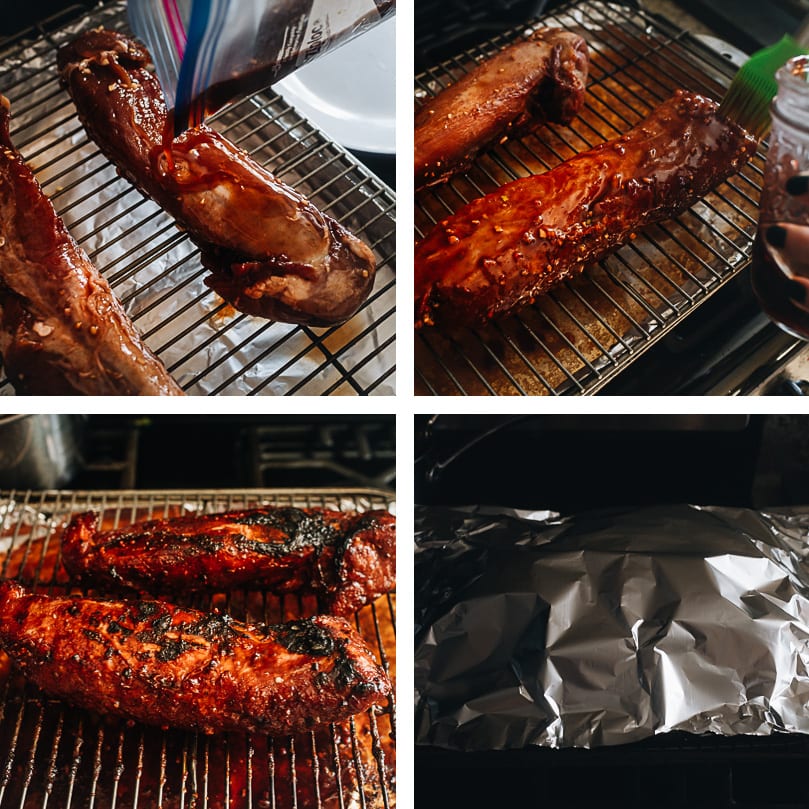

5. Leftovers
Here is the best part. Usually when you have leftovers, they are just waiting to be reheated and consumed the same way. Not with char siu!
If there is any leftover char siu, you can use it to make many popular dishes such as char siu pork lo mein, char siu fried rice, steamed char siu buns, baked char siu buns, wonton char siu noodle soup, and much more.
Afterthoughts
No matter whether you’re planning the menu for your next dim sum party or simply brainstorming for next week’s dinner, Chinese BBQ pork is a great choice. It is easy to prepare ahead of time. It tastes great served either fresh out of the oven or cold. And you can use the leftovers to create so many other delicious dishes.
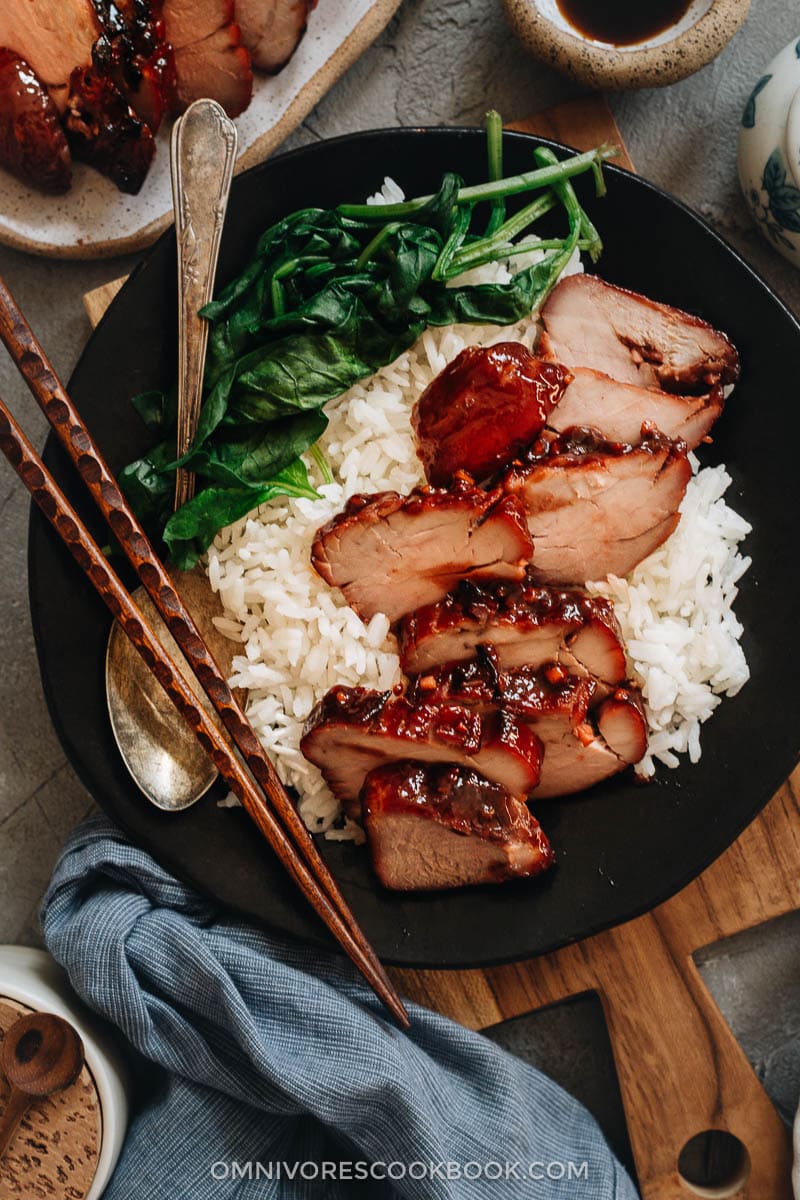
More delicious pork recipes
- Sweet and Sour Pork
- Chinese Lion’s Head Pork Meatballs
- Slow Roasted Crispy Pork Belly (Siu Yuk)
- Mom’s Best Braised Pork Ribs
- Asian-Style Instant Pot Pulled Pork
If you give this recipe a try, let us know! Leave a comment, rate it (once you’ve tried it), and take a picture and tag it @omnivorescookbook on Instagram! I’d love to see what you come up with.
Chinese Cooking Made Easy
Are you new to this website? This free email series is a great place to start. I’ll walk you through a few of my most popular recipes and show you how and why they work. You’ll quickly start to cook better Chinese food in your own kitchen.
Watch video
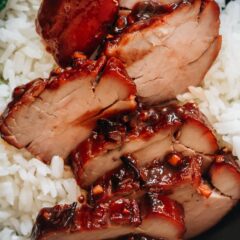
Char Siu (Chinese BBQ Pork, 叉烧肉)
Ingredients
- 2 to 2.5 lbs pork tenderloin (or pork loin)
Sauce
- 1/4 cup soy sauce
- 1/4 cup Shaoxing wine (or dry sherry)
- 1/4 cup hoisin sauce
- 1/4 cup oyster sauce
- 1/4 cup sugar
- 2 tablespoons molasses
- 2 teaspoon garlic , grated
- 1 teaspoon five spice powder
- 3/4 teaspoon salt
- 10 drops red food coloring (Optional)
- 2 tablespoons maltose (or honey)
Instructions
- (Optional) If you’re using pork loin, cut the pork along the grain, into 2 strips about 2” (6 cm) wide and 1”(3 cm) thick. Skip this step if using tenderloin.
- Prepare the marinade and the glaze the day before you cook.
Marinade
- In a large bowl combine the soy sauce, hoisin sauce, oyster sauce, Shaoxing wine, sugar, molasses, garlic, five spice powder, salt, and food coloring (if using). Stir to mix well.
- Transfer the pork into a large ziplock bag. Pour 1/2 cup of the mixed sauce into the bag. Squeeze out as much air as possible and seal the bag. Massage the bag a few times so the pork pieces are covered evenly with the sauce. Transfer to the fridge and marinate overnight (highly recommended), or for at least 6 hours.
Prepare the Glaze
- Microwave the maltose for 20 seconds or so, until the top loosens. Do NOT touch the maltose with your fingers. It’s very hot once it’s heated. Grease your tablespoon with a thin layer of oil. Transfer 2 tablespoons of maltose into a small saucepan. The oil coating on the spoon will help the maltose to fall into the pan without stuck on the spoon.
- Add the rest mixed sauce into the same pan. Heat over medium heat and stir frequently to melt the maltose, until brought to a simmer. Turn to medium low heat. Cook for 5 minutes to thicken the sauce slightly.
- Once done, let the sauce cool for at least 10 minutes. Carefully transfer the sauce into a heat-proof mason jar or container. Let cool for another 10 to 15 minutes. Cover and transfer into the fridge. The sauce will continue to thicken once chilled.
Roasting
- When the pork is marinated and the glaze is chilled, you’re ready to cook.
- Preheat the oven to 450 degrees F (230 C). Line a large baking tray with aluminum foil and add 1/4 inch (1/2 cm) water. Place a grilling rack on top. (Alternatively, you can grill the pork as well)
- Transfer the pork onto the grilling track. Drizzle a few tablespoons marinating liquid onto the pork. Bake for 10 minutes.
- Baste the pork, using a brush to dab the glaze onto the top side. Turn to the other side and dab glaze on top. Bake for 5 minutes.
- Baste the top of the pork, and bake for another 5 minutes. Once done, you can check the doneness by inserting a thermometer into the thickest part of the pork. It should read at least 145 F (63 C). Return the pork to the oven to bake for another 5 minutes or so if needed.
- Turn on the broiler. Broil for 3 minutes. Flip the pork to baste the other side. Broil for another 3 minutes. The pork should look glossy, lightly charred, and cooked through.
- Once the pork is done, brush it with the rest of the glaze. Cover loosely with aluminum foil. Let rest for 10 to 15 minutes before serving.
- You can serve the pork hot over rice as a main dish, or at room temperature as a cold appetizer. It’s super delicious either way.
Storage & other uses
- You can use the char siu drippings and meat to make char siu gravy (served with homemade scallion biscuits).
- You can use leftover char siu to make char siu fried noodles, char siu fried rice, and char siu buns (recipes coming soon!)
- To store the char siu, place it in a sealed container or bag and store it in the fridge for up to 4 days, or in the freezer for up to 1 month.
Nutrition

Did you make this recipe?
I’d love to hear how it turned out for you! Please take a moment to leave a 5-star rating ⭐️ and share your thoughts in the comments further down the page. It really helps others discover the recipe too.
Lilja Walter is a part of the Omnivore’s Cookbook team and worked closely with Maggie to develop and test this recipe.
The original recipe was published on Jan 25, 2016 and updated by Oct 16, 2019.

Tony Gabud
Tried recipe word for word,the taste was fantastic the pork tender and the wife loved it,quick stir fry of vegetables along with some udon noodles made this meal complete,loving how easy this was from start to finish
Phyllis
Just a follow-up to my Feb 1, 2018 post… After making 2 port tenderloins (1 lb. each) I cut up the second one into strips (as in pork lo mein) and froze in 3 portion separate baggies. The next couple of times I made lo mein, and stir fried veggies, I took a baggie out of freezer and let it defrost a bit, then threw in towards the end of stir frying to warm up with rest of dish. It was perfect!! It’s great to know you have something handy like this in the freezer, so I’ll do the same thing next time I make this recipe!
Phyllis Lenkowsky
This came out sooo delicious- tasted just like in Chinese restaurant! it was my second time making it! I buy pork tenderloins when I can find about a 2 -3 pound package (which conains 2 tenderloins) . The first night we (my husband and I) have it sliced with rice and vegeables (napa and bean sprout stir fry) on the side. The second night I slice the remaining half of the first tenderloin into strips and make pork lo mein or stir fry with vegetables. So I’m going to experiment and cut up the remaining tenderloin into strips and freeze it in 2 or 3 portion baggies and use for other stir fry dishes.! Will see how that works because it’s just too much to use all at once (unless you have more than 2 to feed!)
Also, I have the book mentioned in another comment “The Gourmet Chinese Regional Cookbook” by Calvin and Audrey Lee, copyright 1976, given to me by my Mom! I’ve used many of the stir fry recipes over the years and earned how to do Chinese stir fry from these recipes! Also enjoyed the informative history about the various regions and cooking styles. About 2 or 3 years ago I started rereading it since my son is living in Shanghai and wanted to learn about cooking there. It’s amazing how so much of the book is still so current! The only thing changed is that Chinese products are so much more available! Thank you for all the information and recipes on your website! Looking forward to trying new things and learning!
Maggie
Hi Phyllis, thanks so much for leaving such a thoughtful comment and I’m so happy to hear you enjoyed the dish! It’s really smart of you to cook a big batch. I believe the meat freezes well so no worries there. I love to add them into fried rice, noodles and stir fried veggies. It is just a great way to make a fast meal with lots of veggies.
I actually located the “The Gourmet Chinese Regional Cookbook” later and now I have a copy. You’re totally right that the book is still so current and the recipes are classic 🙂
Hope you have a great week ahead and can’t wait to hear what you’ll cook the next!
L. Ness
I have found that good, quite sweet char siu (aka Chinese BBQ pork) does not need much soy sauce, if any.
Nor is 5 spice required. Too many odd flavors….
For 1.5 pounds of pork (preferably shoulder), about 5 tbsp of honey, 4 tbsp of sugar, and a tsp of salt (with a sprinkling
of ground ginger and also garlic) makes a fine marinade. 2 tbsp of Shaoxing rice cooking wine and a little water to thin just a bit completes the mix. I make enough marinade to nearly cover the meat as it sits fairly crowded into a 6×6 container + lid.
I have had great success first slicing the meat in a semi-frozen state (cuts easily and retains its shape) and then holding it together on thin bamboo skewers. That allows the marinade to actually provide great color throughout (using 1/3 – 1/2 tsp of red coloring). Then it’s into the fridge for 20-24 hours! I cut the skewers to length so the assemblies fit into the container.
40 minutes baked (flipped once so 20 minutes each side @350) and then broiled both sides to develop the char/glaze, and the
finished product is very tasty; restaurant style, if you will, which is what MOST folks seem to be searching for.
Soy sauce just doesn’t do it here, at least not much of it; perhaps a tbsp if any. Pork when cooked has a good flavor all on its own, and this famous appetizer is no good if not sweet; honey and sugar are the keys, otherwise one is just making spicy, dull tasting pork.
Try it, you’ll like it….I have photos if you wish to see….
L. Ness
I made this again, but used a pork tenderloin. Everything else I did about the same,
and it turned out well.
Do you think restaurants or wholesale outlets color their product after it is cooked and
sliced? I have to wonder, because even 36-48 hours in the fridge does not allow the color
from the marinade to penetrate whole chunks of pork….
They are holding back, not telling the entire story I fear….
So I pre-slice and go from there, though I just might try coloring lightly after cooking a
bunch; not bright red, but probably a few drops of red and a drop of blue.
It could work!
Maggie
Yes, I believe Chinese restaurant uses food coloring. Also, they use maltose instead of honey or sugar, which allows the marinade to coat the meat better. If you really want the color, I would highly recommend to get some maltose from an Asian market and go from there 🙂
Concerned Netizen
Thanks for sharing.! I find using fermented tofu is a great way to get the color. I understand many Chinese chefs use fermented red rice yeast, but it is quite expensive.
Betty G
I am making this now. It smells really authentic! What degree range do you recommend cooking this to? I saw that you used a digital meat thermometer. Thank you for all the beautiful and inspiring pictures.
Betty G
Hi Maggie,
Reading through the recipe again, I found the degrees 140 to 150. Then baste for another 5 minutes. I will try to do this. Thank you!
Maggie
Hi Betty, thanks for trying out this recipe and I’m glad to hear you’ve found the answer of the cooking temperature. Did the char siu pork come out well? I hope you enjoyed the dish 🙂
Betty G
Hi Maggie,
The char siu was , wow. I can’t believe it was that quick to cook that. It was messy, but worth making. I made it once as stated in the post. The next time I cheated and added a slathering of the thick commercial Lee Kum Kee Char Siu Sauce in the last 5 minutes. I was wanting that thick sweet sauce you get at chinese bbqs. My oven was not as powerful as yours I think. I could not get that blackened char that I saw in your post. I raised the meat up the second time to 8 inches away from the flame and made sure I selected high broil. Some ovens have low and high. It had more sizzling this time. The family of 6 ate 3 lbs. of that for dinner. Yum. and thank you for sharing!
Maggie
Hi Betty, thanks for letting me know your cooking result! Yes, I admit the cooking requires quite some effort and is messy. That’s the downside of the home oven.
If you want the thick sweet sauce texture, try to find maltose if you go to an Asian market the next time and use it instead of sugar. You can double the amount of maltose too, to make the sauce sweeter. Maltose has a better adhesive effect and will produce a beautiful shiny glaze. I just recently found it and can’t wait to try it again in this recipe, so I can get a better sauce 🙂
Rik
Char siu is probably one my absolute favorite things. I put a little spin on the recipe though. Pork tenderloin was on sale so I used that, and rather than the red food coloring, I used a splash of grenadine with some red pepper flakes which made for a nice red/pink halo in each cut. Also threw in a splash of bourbon over the wine, because it was all I had hanging around (next time I’ll make sure I have some proper wine on hand – whether it be sherry or shaoxing), as well as a nice tbsp or so of molasses for good measure. Turned out phenomenal! Will definitely be a staple of my grill from this point forward!
Maggie
I’m glad to hear you like this recipe Rik! Thanks for sharing your knowledge of replacing red food coloring. Me too, I’m not a big fan of using too many chemicals in my food, so I prefer the natural food coloring you said. I think adding bourbon works just as well. I use it too, sometimes vodka, when I ran out of Shaoxing wine.
We’ll be grilling some baby back ribs soon and I’ll be trying out some of the tips you shared. Looking forward to it 🙂
Jamie
This recipe is absolutely fabulous. The marinade and cooking method make this recipe a keeper! Yum!
Maggie
I’m glad to hear you enjoyed the dish Jamie! Thank you for taking time to leave a comment 🙂
Kimmy
Greetings from Singapore,
Having chanced upon your site, I was able to cook up a number of selected dishes from your recipes including this BBQ Char Siu.
I have stayed and worked in Hong Kong for more than 12 years and are familiar with authentic and aromatic as well as typical and traditional dishes there having had most of my meals in restaurants, tea houses, dim sums and street hawker fares. I loved them all.
My favorites are the roasted goose, char siu, cheongfun , tarts, naiwong pao, and braised beef briskets ( gao lum) , etc.
I am very impressed with your detailed description and guides on each of your recipe including accompanying sauces and dips, etc.
I have also improved my making of dumplings as a result of your guidance on your site. Thank you.
May I sign off wishing you and your loved ones, good health, happiness and prosperous year ahead.
Best.
Maggie
Hi Kimmy, thanks so much for taking time and leaving a comment! I’ve only been to Hong Kong twice, but me too, I really love the roasted goose and duck, cheongfun, tarts, and beef briskets. I am still trying to learn more about Cantonese cuisine and challenge these dishes at home. Some of the recipes do take some time and effort to make!
I’m glad to hear you find my posts helpful and it always brighten by day when I hear someone tried out my recipes 🙂
You too, hope you have happy and prosperous year ahead! Take care and have a great day 🙂
Atia
This recipe looks amazing! I’m doing it right now! One question, do you know if it’s possible to freeze some of the leftovers?
Thanks!
Maggie
Hi Atia, yes, you can freeze the leftovers without problem! If you have more glaze left, save them as well you can pour them over the char siu while reheat.
Happy cooking and hope the dish turns out well!
Lila
I am wondering if you could use pork tenerloin as well. Is a tenderloin too lean for this cooking method?
Maggie
Hi Lila, sorry I just saw your question! Yes you can use a tenderloin for this recipe. It is a tender lean cut, so it will turn out well as long as you don’t over cook it.
RossC
How wonderful to run across this recipe…
Back at the end of the 1970’s when I was a young 40 years old, my wife and my mother thought I should learn to do more than grill beef and stuff..
They gifted me a wok, some basic tools and a book…
The book, “The Gourmet Chinese Regional Cookbook” by Calvin and Audrey Lee became my introduction to Chinese cooking..
From the South China section of that book , the very first thing I made was a dish we ordered constantly in our favorite Chinese restaurant.. “Chinese Roast Pork”… I made that recipe and others from that book for many years..
As the years went by I moved on to cooking ‘regular American’ dishes but I remember how wonderful that roasted pork was and how much fun and pride I felt with making the perfect Chinese Roast Pork for family and friends ..
When I read your recipe I dug out that first cook book I ever received and looked up the pork recipe.. To my great joy I find that that recipe only differs from yours in a few small ways..
It calls for brown bean sauce (which was very hard to find at the time) instead of hoisin and oyster sauce.. It calls for light brown sugar instead of granulated sugar and I oven roasted it by hanging the pork from the oven rack over a pan of water… Other than that, its like reading that wonderful book all over again, 37 years later..
How wonderful to be reconnected to recipes which connected me to cooking in general and to Chinese cooking in particular…
Thank you… :o)
Maggie
Hi Ross, thanks for leaving such a detailed comment and share your Chinese food experience! The cookbook sounds amazing. I never expected there was a detailed book on Chinese regional cuisine back then. I just ordered a copy from Amazon and can’t wait to read it!
Re hanging the pork in the oven: how you managed to do that? It is actually the proper way that Cantonese restaurants use, with a hook. I can’t find a way to do it so I need to place the pork on the roasting pan.
Hopefully you’ll find more Chinese recipes to try out from my blog 😉 Happy cooking and have a great holiday!
RossC
I’m happy you found a copy of the Lee’s book…The Chinese Roast recipe is on page 203, in my edition..Its been bookmarked for over 30 years.. It would be good to know if the book fits in with what you do…
I was given small hooks by a butcher friend.. You can find them now on in a restaurant supple store or on by searching for ‘small meat hanging hooks’ on Amazon..
And yes, I am finding many wonderful Chinese recipes on your blog… :O)
Maggie
Hi Ross, thanks for sharing the tip on how to hang the pork in the oven!
The book just arrived a few days ago and I love it! It’s nice to see a Chinese cookbook that covers Chinese cuisine by regions, because each region has so many different cooking habits and signature dishes.
Happy New Year!
Marilyn Jacobs
Hi –
Loved this dish. I have tried different recipes for Char Siu and this is my favorite for the flavor marindade and techniqe of cooking at high temperature. I got a large pork loin on sale and made this in 2 batches. Is it possible to freeze this after it is cooked?
Thanks so much.
Marilyn Jacobs
Indianapolis, IN
Sarah
So we should use the broiler, but the pork is not being placed right under the broiler element since it says “Place oven rack in the lower third of the oven,….”? Or is the broiler element in your oven in the bottom of the oven? Thank you!
Maggie
Hi Sarah, the broiler element in my oven is on the top. I turned on the broiler but keep the oven rack very low, because I want the sauce to caramelize during the whole process, while cooking through the pork, and not to burn the surface. I’ve tried several methods for this recipe. I found out if you bake the pork and turn on the broiler at the end, the result wasn’t good enough, since you can only apply the sauce one or two times before it burn the surface. The key is to apply sauce as many times as possible during the roasting, so it forms the coating outside the pork. I hope this is not too confusing!
circe801
made this tonight. easier (and better) than my previous method. i think the marinade’s a little better as well. made some veg llo mian to go with it. thanks, maggie!!
Maggie
Glad to hear your dish turned out well! These char siu will go great on the lo mian. Good choice 🙂
You’re the most welcome and have a fantastic day!
Caroline from Portland
Maggie – Your Char Siu Recipe is the Bomb Diggity. Even my Chinese parents LOVED it. It’s a keeper. Thanks!
Maggie
I’m so glad to hear it Caroline! Have a great week ahead 🙂
Kevin | Keviniscooking
Love this line you wrote, “Combining the local BBQ culture with my Chinese culture, I chose to share this Chinese BBQ char siu recipe with you today, to celebrate Chinese New Year!” So apropos!
This looks so good I want to lick my laptop screen and agree, this is so versatile. Happy New Year and thanks Maggie!
Boastful Food
Wow! Beautiful dish! Will have to pin to try out later. Have always wanted to try my hand at char siu. Thanks for sharing:)
Tamara
I was excited to see this recipe Maggie! I make Char Siu Bao (only for special occasions like birthdays) as it is a family favorite. I think the Char Siu recipe I’ve used took longer, though, so I’m pinning yours, and will give it a try next time!
simon
Thanks for sharing your recipe! Char Siu is simply amazing! One of my favorite marinades! IT’s perfectly suitable for BBQ so you made a good decision 😉
Tom Andersen
Thanks Maggie. I just printed this one to save.
Made a BIG note at the bottom to Refer to Bookmarks: Chinese BBQ Char Siu Maggie to view pictures!
Thanks for another Mouth watering Experience!!!!
Maggie
So glad you like this one too Tom 🙂 It’s so easy to cook and you can use the leftover char siu in many dishes!
Kit Graham
I love the step by step photos. This recipes looks really do-able!